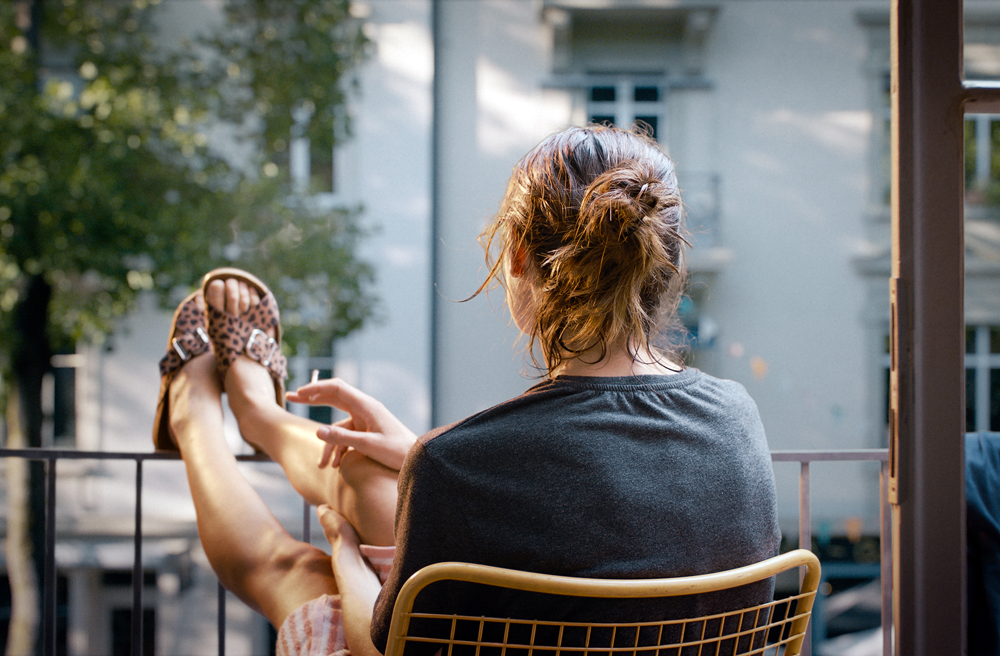When watching “The Girl and the Spider,” it may seem like no time has passed at all between Ramon Zürcher’s debut feature “The Strange Little Cat” and his latest collaboration with his brother Silvan, but in fact it’s been nearly a decade since the Swiss siblings took the world by storm with a truly innovative drama in which both chronology and geography were made to feel more like narrative manipulations of the mind rather than the constructs of a film production, set in a single location as a family’s entire past rose to the surface. If “The Strange Little Cat” felt like a magic trick, spellbinding as it inspired curiosity at every turn about what life existed beyond the walls of what you were privy to, the Zürchers’ follow-up assures that it was no one-time feat, though “The Girl and the Spider” is no less tantalizing, centered on a simple act of a pair of roommates named Lisa (Liliane Amuat) and Markus (Ivan Georgiev) moving out of the apartment they’ve shared with Mara (Henriette Confurius) for years, creating a ripple effect in her impending absence as Mara recalls the history they’ve had collectively and to the space that they’ve shared and confronts a future without them.
Even though Lisa and Markus are hardly moving far away, as anyone knows at the end of the longterm relationship, it might as well be another planet from Mara when the intimacies of their daily routine cannot be replicated and have to be reimagined. Cinematically, the Zürchers’ novel approach reflects Mara’s own psychological reengineering of the life in front of her, as people come and go from the apartment as they always have, but at a torrid pace where it feels as if she’s grasping for connections when she once was so in sync, and memories of close acquaintances are as tangibly a part of her surroundings as anyone currently in her life. The apartment may be remodeled in the wake of Lisa and Markus’ departure, but “The Girl and the Spider” unfolds as a deconstruction as Mara comes to realize what she should hold onto and let go with this obvious turning point, moving towards what is vivid and inspiring and letting all else fall away.
In an era when “meditative” is often deployed as slang for “ponderous,” “The Girl and the Spider” induces self-reflection in an exhilarating way, making news of a third film building on the success the Zürchers have had with their first two most exciting news, as well as the opportunity to finally see their latest film on American shores this week, beginning with a run at New York’s Metrograph and Film at Lincoln Center before spreading out across the country. While the two were last in Manhattan — at least virtually when “The Girl and the Spider” was selected by the New York Film Festival following its premiere at Berlinale 2021 where the duo won best director — they spoke about creating ambiguity that allows the audience to plant their own seeds for suspense and pulling the overactive playground of the mind into every one of their carefully considered frames.
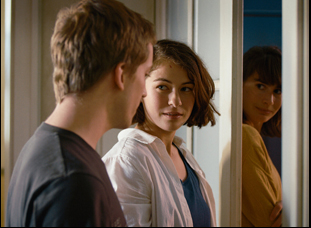
Silvan Zürcher: Actually when Ramon started to write “The Strange Little Cat” or even when he finished the script, there was no conception of a trilogy at all. I started to write “The Girl and the Spider” while Ramon started another film script, “The Sparrow and the Chimney,” and then we started to realize there’s like familiarities among the three films – the cat, the spider and the sparrow and that they’re formal siblings in a way, but there’s also many other aspects that they have in common — it’s about families and the relationship between mothers and children, and “The Cat” takes place on one day, “The Spider” on two days and “The Sparrow” on three days, so it’s also in a way a widening of the range time-wise, but also spatially as “The Strange Little Cat” takes place in one apartment, “The Girl and the Spider” in two buildings with many different apartments and “The Sparrow and the Chimney” actually in a village. So we started to think about these three films in terms of [being cinematic] siblings.
Is it true this is based on your own experience of separating as roommates?
Silvan Zürcher: Actually, it happened while writing because after “The Strange Little Cat,” we still lived together and as we’re twin brothers, it was also in a way symbiotic. While I was writing “The Girl and the Spider,” Ramon moved from our shared flat to his own single flat apartment and this very experience was the skeleton for “The Girl and the Spider,” but just the starting point. It was not really based on this autobiographical moment, but the two of us have notebooks where we collect every day observations and stories we’ve been told by friends and also inventions of ours, and we started to decorate the skeleton with these pearls we collected.
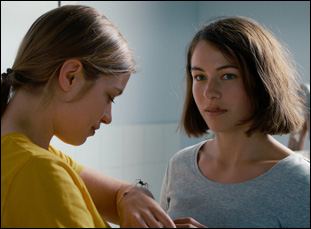
Ramon Zürcher: The only thing we knew were there were those two flats, the old flat where there are those friendships with the other characters, and more traces of more things [that] happened, like the old life and then there’s the new flat, the new space, and the unwritten, neutral space that doesn’t have [those] traces yet. The structure is not that the film makes the journey from the old to the new, but it starts at the new and then after we’ve spent the first 30 minutes there, we go back, and formally, it’s actually very simple, we move from one flat to the other, but [when] it goes from the present flat to future flat, back to the past flat, it becomes something nonlinear.
Otherwise, how to show the space and how to work with the camera, we felt quite early that those films would be quite similar. Here we play with a static camera and a rather joyful mise en scene, so that the movement and the images are from the moving characters. Those formal decisions we had quite early, but because now you don’t see so many wide shots in the film, we didn’t have that concept. It was just a consequence of drawing the story design and then it became a rather claustrophobic space/universe where sometimes you don’t know am I now in [which] flat and you kind of lose where you are. We found that interesting because sometimes you’re not sure is [Lisa] the daughter of Astrid, is [Markus] the flatmate? Is there like a love interest? Is it rather friendship or love? Actually, it’s a fluid realm where you read the signs to put together the puzzle and we like that visual language of claustrophobia in which immense things are happening off-screen and only the concentration of what you see is really a focus.
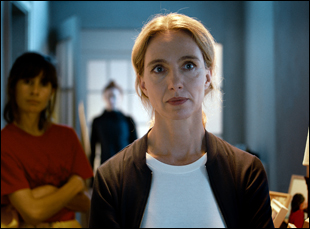
Silvan Zürcher: We don’t really preconceive the openness of things a lot. Thinking about the perspective of the film, we like the idea of as if an alien would land on earth and be set in the middle of a specific situation and it doesn’t have preconceived notions of this very situation. There’s no orientation. It doesn’t know who is who or what’s the quality of the relations that connect the people to one another. We don’t like that the film starts and the audience [is] the spectators — there are not establishing shots or classically orienting expositions about the character constellation, nor about the film in space, so we do like having this phenomenological approach that audience just has to observe carefully the visual and the sound and then take the pieces they observe and create their theory about how these characters are obsessed by one another, for example, or who desires whom.
We find it’s closer to realism to have these question marks because when we are set as a person in a specific situation we don’t know, we also have to be related to the people we have in front and to the situation. In this question mark style, we have to observe and slowly we build our comprehension of this situation. And what we also tried with this film was to not have things preconceived, but also the audience is like a detective. There’s a consequence of openness that actually we don’t want to lose our audience by having too many questions so they lose interest, but it’s really a balance to have enough anchors that people know enough just to be involved, but still to have like things not overdetermined or maybe not determined, so after seeing the film, there might be severe theories about what has been going on.
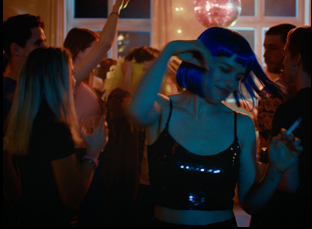
Ramon Zürcher: Years ago, I saw the film “Beloved Sisters” by Dominik Graf and I was always a little bit confused that [was where my main impression came from], not so much in the other films because I loved her presence, but mostly actually the eyes and the intense gaze, so we actually cold cast her. Then she spoke those difficult dialogues, which in German when you read them, it’s a little bit artificial because most people don’t speak like that. It’s not so naturalistic written, so if an actor speaks [accordingly], it’s going to be too artificial so when you see an actress or an actor working, it’s difficult to [see] as if a person really speaks them, that if you don’t have a reflective effect, you’re connected and not, like in a zoo where you watch what is happening. And [Henriette] had that very naturalistic, normal use of the dialogue and also a certain sensitivity because the character is a little bit destructive, a little bit mean, a little bit of a monster. She lies and she’s not so much darling and we found it interesting to use her a little bit of a contrast to Mara as written — Mara came to Henriette and when they melt, it’s more complex because if we had taken an actress already like that, then it wouldn’t be so ambiguous.
“The Girl and the Spider” opens on April 8th in New York at Film at Lincoln Center and Metrograph and April 15th in Los Angeles at the Laemmle Royal, followed by a national rollout. A full list of theaters and dates is here.




